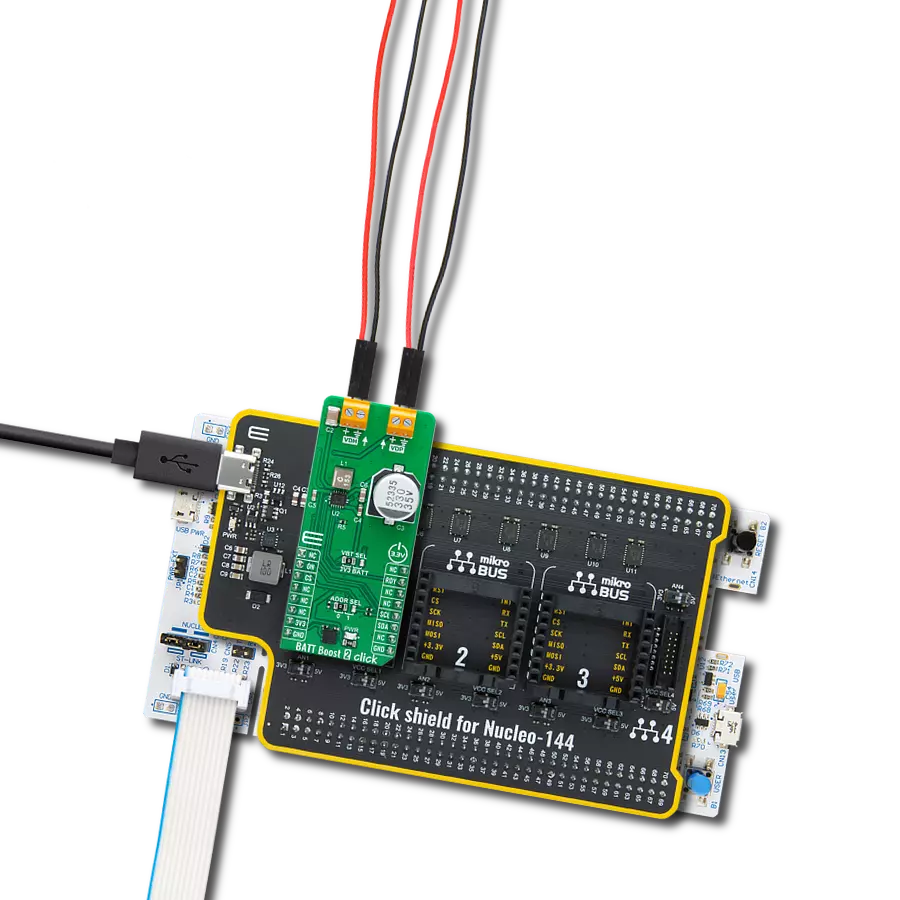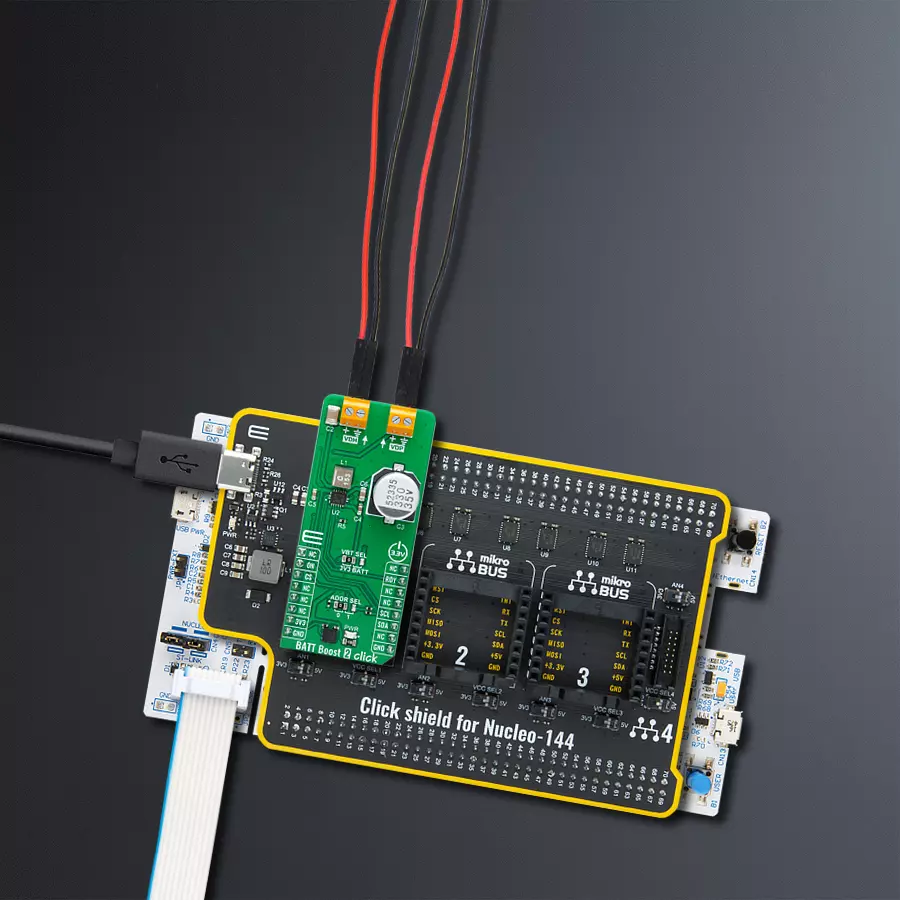Extend battery life in low-power devices with smart power management perfect for IoT sensors, industrial devices, and wearables
A
A
Hardware Overview
How does it work?
BATT Boost 2 Click is based on the NBM7100A, a coin-cell battery-life booster with adaptive power optimization from Nexperia, designed to extend the battery life of non-rechargeable, primary batteries in low-voltage, low-power applications. This innovative solution is specifically designed to address the voltage drops and battery life limitations typically associated with high pulse current demands from primary batteries like the CR2032 coin cell attached to the back of the board. The NBM7100A's adaptive learning algorithm monitors the system's energy consumption and optimizes the internal DC-DC conversion process to manage the remaining charge in the storage capacitor efficiently, reducing energy waste. This makes BATT Boost 2 Click ideal for powering wireless IoT sensors, industrial devices, and wearable consumer electronics where efficient battery usage is crucial, especially in applications with high internal battery impedance and frequent bursts of power demand. As mentioned, the NBM7100A integrates two high-efficiency DC-DC conversion stages and employs an intelligent learning algorithm to maximize the usable capacity of primary batteries. The first stage draws energy at a low, steady current from the battery and stores it in a capacitor. This stored energy is then released
during the second stage of DC-DC conversion to supply a stable, regulated voltage with high pulse load capability on the VDH output terminal. This design allows the device to handle bursts of current, up to 200mA, without directly taxing the battery with large pulse currents, ensuring a longer, more predictable battery lifespan. In addition to the VDH terminal, BATT Boost 2 Click features another output labeled VDP, which serves as a 'permanent' supply terminal with a maximum output current of 5mA. The VDP terminal is ideal for powering 'Always-ON' system components, such as the core and I/O of a host MCU. On the power supply side, the main power supply for the NBM7100A can be sourced either from the 3.3V mikroBUS™ socket or the attached coin battery on the back of the board, with the selection made via the VBAT SEL jumper. The NBM7100A offers three distinct operating modes: Continuous, On-demand, and Auto mode. Continuous mode suits applications requiring immediate pulse load capability, ensuring the system can respond quickly to power demands. On-demand mode, on the other hand, is optimized for extending battery life in low-duty cycle applications, where the system remains in sleep mode for extended periods. Auto mode automates the process of managing power transitions between
charging and active states without requiring constant oversight from the serial bus, using a HIGH logic level from the ON pin on the mikroBUS™ socket for control. BATT Boost 2 Click uses a standard 2-wire I2C communication protocol, allowing the host MCU to control the NBM7100A, modify default configuration settings, and retrieve system information. The I2C interface supports clock frequencies up to 1MHz, with the device address selectable via the ADDR SEL jumper, which can be set to either position 0 or 1, corresponding to I2C addresses 0x2E or 0x2F. Additionally, several pins from the mikroBUS™ socket are used for further control of the NBM7100A: the ON pin manages the above-mentioned Auto mode, while the RDY pin provides a HIGH logic signal indicating that the NBM7100A is ready to deliver full power to the connected load. This Click board™ can be operated only with a 3.3V logic voltage level. The board must perform appropriate logic voltage level conversion before using MCUs with different logic levels. Also, it comes equipped with a library containing functions and an example code that can be used as a reference for further development.
Features overview
Development board
Nucleo-144 with STM32F303ZE MCU board offers an accessible and adaptable avenue for users to explore new ideas and construct prototypes. It allows users to tailor their experience by selecting from a range of performance and power consumption features offered by the STM32 microcontroller. With compatible boards, the
internal or external SMPS dramatically decreases power usage in Run mode. Including the ST Zio connector, expanding ARDUINO Uno V3 connectivity, and ST morpho headers facilitate easy expansion of the Nucleo open development platform. The integrated ST-LINK debugger/programmer enhances convenience by
eliminating the need for a separate probe. Moreover, the board is accompanied by comprehensive free software libraries and examples within the STM32Cube MCU Package, further enhancing its utility and value.
Microcontroller Overview
MCU Card / MCU

Architecture
ARM Cortex-M4
MCU Memory (KB)
512
Silicon Vendor
STMicroelectronics
Pin count
144
RAM (Bytes)
81920
You complete me!
Accessories
Click Shield for Nucleo-144 comes equipped with four mikroBUS™ sockets, with one in the form of a Shuttle connector, allowing all the Click board™ devices to be interfaced with the STM32 Nucleo-144 board with no effort. This way, MIKROE allows its users to add any functionality from our ever-growing range of Click boards™, such as WiFi, GSM, GPS, Bluetooth, ZigBee, environmental sensors, LEDs, speech recognition, motor control, movement sensors, and many more. Featuring an ARM Cortex-M microcontroller, 144 pins, and Arduino™ compatibility, the STM32 Nucleo-144 board offers limitless possibilities for prototyping and creating diverse applications. These boards are controlled and powered conveniently through a USB connection to program and efficiently debug the Nucleo-144 board out of the box, with an additional USB cable connected to the USB mini port on the board. Simplify your project development with the integrated ST-Link debugger and unleash creativity using the extensive I/O options and expansion capabilities. This Click Shield also has several switches that perform functions such as selecting the logic levels of analog signals on mikroBUS™ sockets and selecting logic voltage levels of the mikroBUS™ sockets themselves. Besides, the user is offered the possibility of using any Click board™ with the help of existing bidirectional level-shifting voltage translators, regardless of whether the Click board™ operates at a 3.3V or 5V logic voltage level. Once you connect the STM32 Nucleo-144 board with our Click Shield for Nucleo-144, you can access hundreds of Click boards™, working with 3.3V or 5V logic voltage levels.
Used MCU Pins
mikroBUS™ mapper
Take a closer look
Click board™ Schematic

Step by step
Project assembly
Track your results in real time
Application Output
1. Application Output - In Debug mode, the 'Application Output' window enables real-time data monitoring, offering direct insight into execution results. Ensure proper data display by configuring the environment correctly using the provided tutorial.

2. UART Terminal - Use the UART Terminal to monitor data transmission via a USB to UART converter, allowing direct communication between the Click board™ and your development system. Configure the baud rate and other serial settings according to your project's requirements to ensure proper functionality. For step-by-step setup instructions, refer to the provided tutorial.

3. Plot Output - The Plot feature offers a powerful way to visualize real-time sensor data, enabling trend analysis, debugging, and comparison of multiple data points. To set it up correctly, follow the provided tutorial, which includes a step-by-step example of using the Plot feature to display Click board™ readings. To use the Plot feature in your code, use the function: plot(*insert_graph_name*, variable_name);. This is a general format, and it is up to the user to replace 'insert_graph_name' with the actual graph name and 'variable_name' with the parameter to be displayed.

Software Support
Library Description
This library contains API for BATT Boost 2 Click driver.
Key functions:
battboost2_set_vset- This function is used to control the output voltage levels of the NBM7100ABQX, Coin cell battery life booster with adaptive power optimization on the BATT Boost 2 Click.battboost2_high_impedance_mode- This function is used to configures the VDH high-impedance mode in Standby and Active states of the NBM7100ABQX, Coin cell battery life booster with adaptive power optimization on the BATT Boost 2 Click.battboost2_set_on_pin_state- This function sets the desired states of the ON (RST) pin of the NBM7100ABQX, Coin cell battery life booster with adaptive power optimization on the BATT Boost 2 Click.
Open Source
Code example
The complete application code and a ready-to-use project are available through the NECTO Studio Package Manager for direct installation in the NECTO Studio. The application code can also be found on the MIKROE GitHub account.
/*!
* @file main.c
* @brief BATT Boost 2 Click example
*
* # Description
* This library contains API for the BATT Boost 2 Click driver.
* This driver provides the functions to control battery energy management
* device designed to maximize usable capacity from non-rechargeable.
*
* The demo application is composed of two sections :
*
* ## Application Init
* Initialization of I2C module and log UART.
* After driver initialization, the app executes a default configuration,
* sets the output voltage to 1.8V, charge current to 16mA,
* and early warning voltage to 2.6V.
*
* ## Application Task
* This example demonstrates the use of the BATT Boost 2 Click board.
* The demo application uses two operations in two states:
* the charging state and the active state. First, when the device is in a Charge state,
* the external storage capacitor is charging from VBT using a constant current
* and displays storage capacitor voltage levels and charge cycle count.
* Upon completion of a Charge state, the device transitions to the Active state
* at which time VDH becomes a regulated voltage output of 1.8V (default configuration),
* displays storage capacitor voltage level, and monitors alarms
* for low output voltage (below 1.8V) and early warning (below 2.4V).
* Results are being sent to the UART Terminal, where you can track their changes.
*
* @author Stefan Ilic
*
*/
#include "board.h"
#include "log.h"
#include "battboost2.h"
static battboost2_t battboost2;
static log_t logger;
void application_init ( void )
{
log_cfg_t log_cfg; /**< Logger config object. */
battboost2_cfg_t battboost2_cfg; /**< Click config object. */
/**
* Logger initialization.
* Default baud rate: 115200
* Default log level: LOG_LEVEL_DEBUG
* @note If USB_UART_RX and USB_UART_TX
* are defined as HAL_PIN_NC, you will
* need to define them manually for log to work.
* See @b LOG_MAP_USB_UART macro definition for detailed explanation.
*/
LOG_MAP_USB_UART( log_cfg );
log_init( &logger, &log_cfg );
log_info( &logger, " Application Init " );
// Click initialization.
battboost2_cfg_setup( &battboost2_cfg );
BATTBOOST2_MAP_MIKROBUS( battboost2_cfg, MIKROBUS_1 );
if ( I2C_MASTER_ERROR == battboost2_init( &battboost2, &battboost2_cfg ) )
{
log_error( &logger, " Communication init." );
for ( ; ; );
}
if ( BATTBOOST2_ERROR == battboost2_default_cfg ( &battboost2 ) )
{
log_error( &logger, " Default configuration." );
for ( ; ; );
}
log_info( &logger, " Application Task " );
Delay_ms ( 100 );
}
void application_task ( void )
{
float vcap = 0;
uint8_t status = 0;
uint32_t chenergy = 0;
if ( BATTBOOST2_STATUS_READY != battboost2_get_ready( &battboost2 ) )
{
if ( BATTBOOST2_OK == battboost2_set_op_mode( &battboost2, BATTBOOST2_OP_MODE_CHARGE ) )
{
log_printf( &logger, "\nOperating state: Charge\r\n" );
}
if ( BATTBOOST2_OK == battboost2_get_vcap( &battboost2, &vcap ) )
{
log_printf( &logger, " Capacitor Voltage: %.2f V \r\n", vcap );
}
if ( BATTBOOST2_OK == battboost2_get_chenergy( &battboost2, &chenergy ) )
{
log_printf( &logger, " Charge cycle count: %lu \r\n", chenergy );
}
Delay_ms ( 1000 );
}
else
{
if ( BATTBOOST2_OK == battboost2_set_op_mode( &battboost2, BATTBOOST2_OP_MODE_ACTIVE ) )
{
log_printf( &logger, "\nOperating state: Active\r\n" );
if ( BATTBOOST2_OK == battboost2_get_vcap( &battboost2, &vcap ) )
{
log_printf( &logger, " Capacitor Voltage: %.2f V \r\n", vcap );
}
if ( BATTBOOST2_OK == battboost2_get_status( &battboost2, &status ) )
{
if ( BATTBOOST2_STATUS_EW & status )
{
log_printf( &logger, " Status: Early warning.\r\n" );
}
if ( BATTBOOST2_STATUS_ALRM & status )
{
log_printf( &logger, " Status: Low output voltage in the Active state.\r\n" );
}
}
}
Delay_ms ( 1000 );
}
}
int main ( void )
{
/* Do not remove this line or clock might not be set correctly. */
#ifdef PREINIT_SUPPORTED
preinit();
#endif
application_init( );
for ( ; ; )
{
application_task( );
}
return 0;
}
// ------------------------------------------------------------------------ END


































